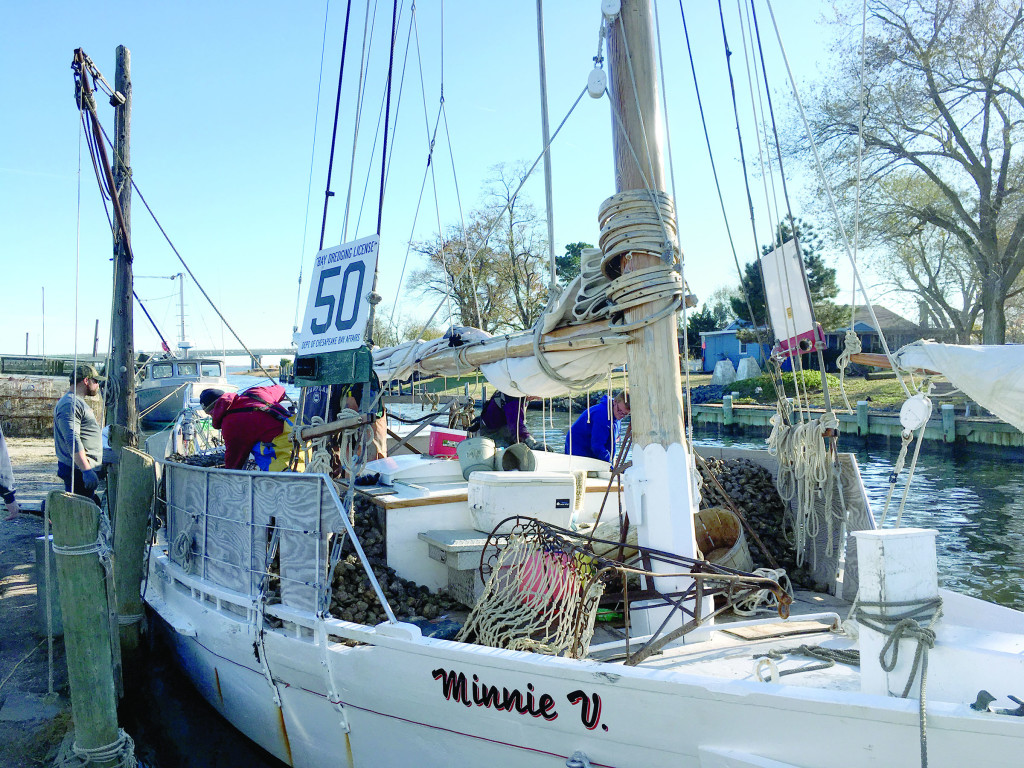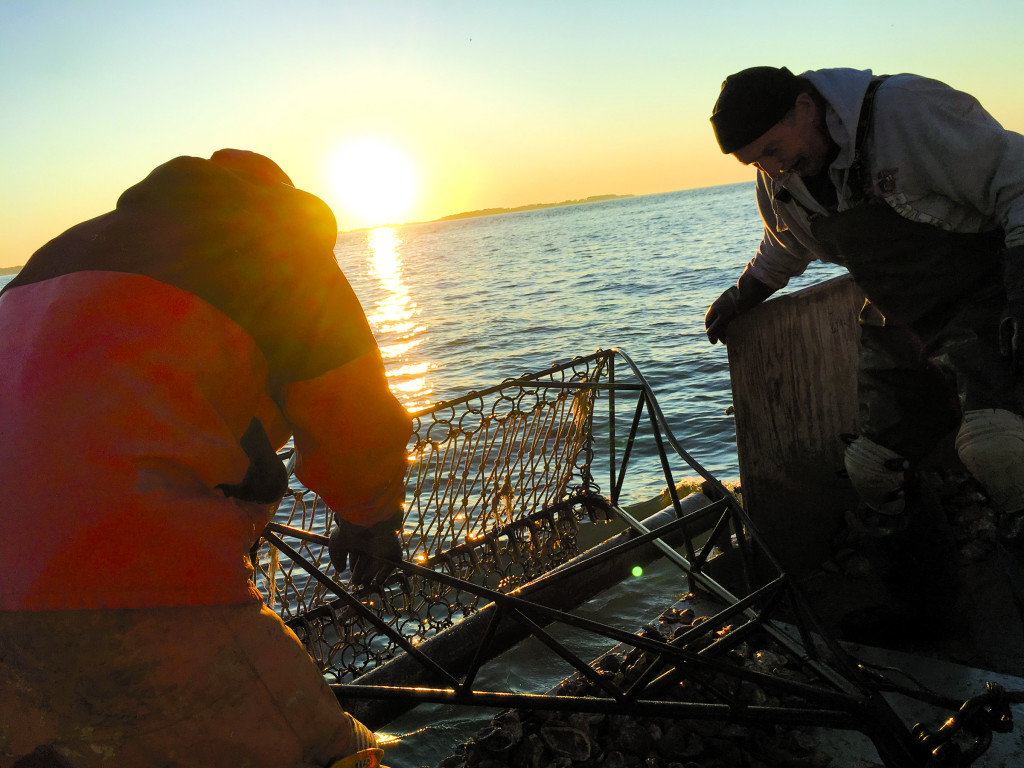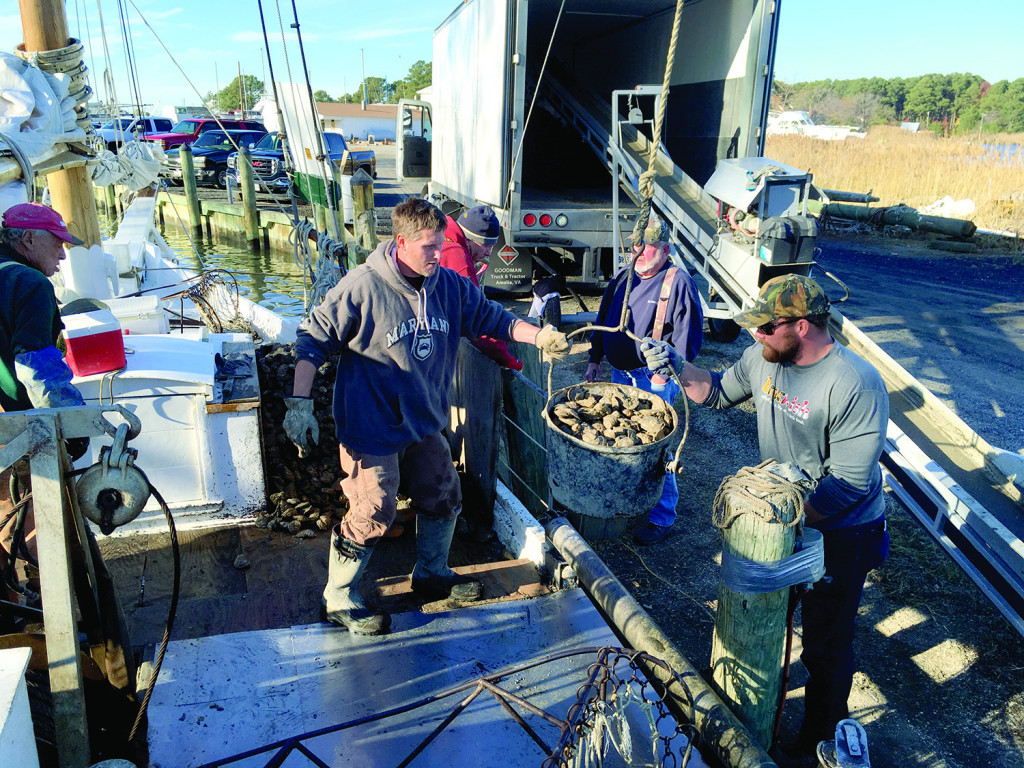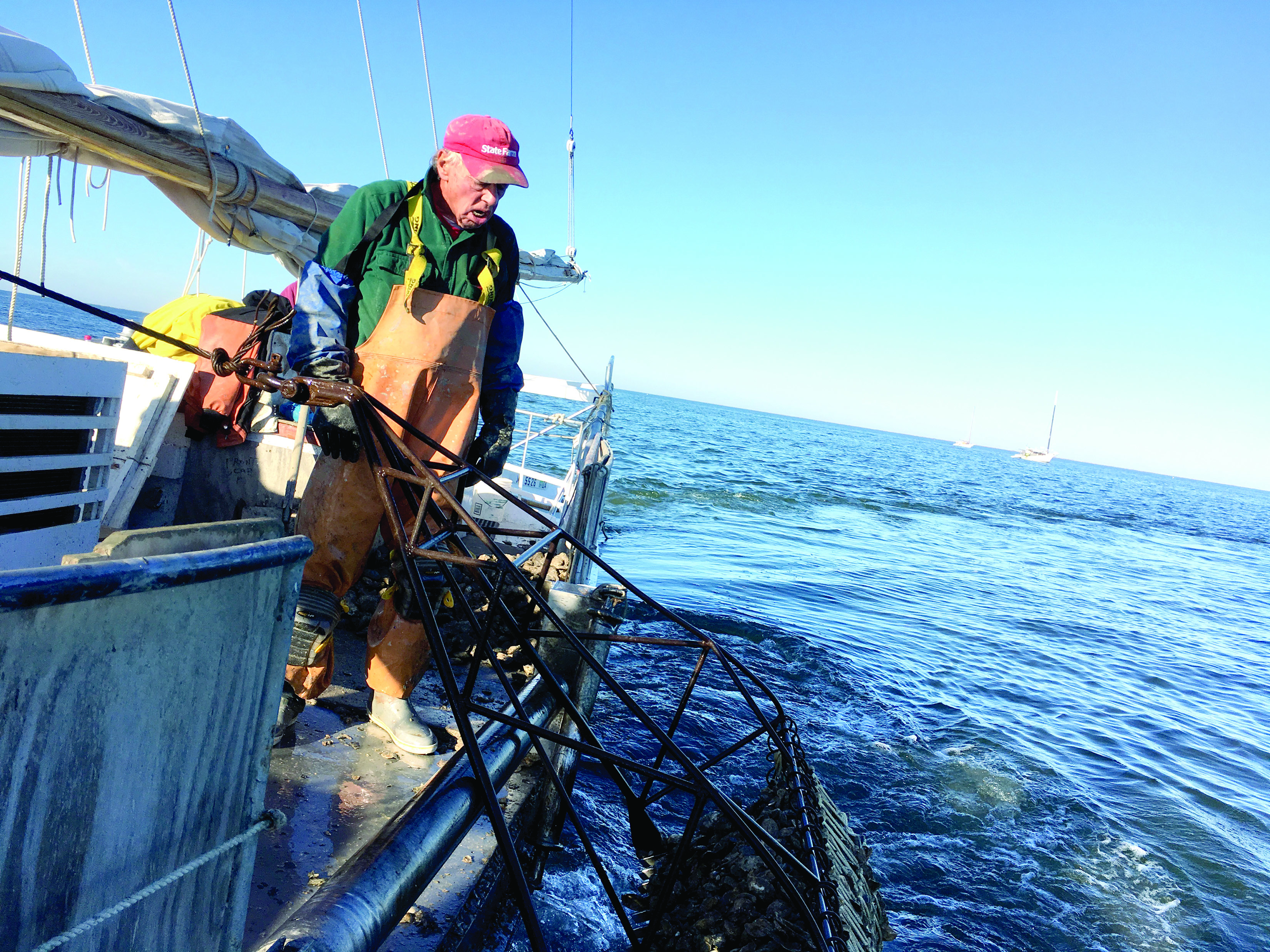It’s 2:30 in the morning at the remote airport parking lot in South Philly. “Is this your truck?” the valet asks.
I’m looking at a 2020 GMC 2500 Denali, loaded. “Yeah,” I tell the guy.
“Man, what do you do?”
“I’m a writer.”
He shakes his head in disbelief.
Fifteen minutes later I’m on the road to Chance, Md., but still no word from Stoney Whitelock, owner of the Minnie V., a 45-foot skipjack used in the Maryland oyster fishery. It’s the Tuesday before Thanksgiving (2019), and the only shot we have at a trip, so I’m hoping it works out.
It’s still dark in Chance as the engines of the little oyster fleet come to life and boats start to slide out of the Scott’s Cove Marina. The Minnie V. lies at the end of the wharf, easily spotted by her 60-foot mast, her sails furled.
By luck, Whitelock and his crew are there, preparing for a day of dredging oysters in Tangier Sound.
“We’ve got legends aboard,” says 72-year-old Whitelock, as he introduces the crew, including 73-year-old Tom Daniels and 77-year-old Dick Webster.
“I’ll be 78 tomorrow,” says Webster, who holds the license and captains the boat.
“And we got these young guys,” says Whitelock, introducing James Corbin, Shawn Fridley and Jay Abbot, all in their 30s and 40s.
The Minnie V. has no engine, only sails — Maryland’s skipjacks have traditionally fished under sail. But since the late 1960s they have been allowed to use pushboats. Under current rules, the skipjacks can fish on Mondays, Tuesdays, Thursdays and Fridays. They can use power on any two of those days, and sail the other two. Today is a power day, and Whitelock climbs over the stern into the pushboat to start the 4-cylinder Cummins.
“She’s about 20 years old,” Whitelock says of the Cummins. “But she ain’t got many hours on her.” The Minnie V., on the other hand, has a lot of hours on her. “She was built in 1906,” says Whitelock. “I bought her four years ago from the city of Baltimore. They were just using her for tourists and taking good care of her.”
As the sun rises, the boat emerges into the bay and Webster at the helm heads for Tangier Sound, where a dozen other boats are already at work.
“It’s the only place we got left,” says Whitelock. “But they’re going to open that up next week,” he says, pointing north. “There’s two rocks up there.” According to Whitelock, one of the rocks ought to be good for the skipjacks, but the other is in water so shallow it will only be good for the tongers — boats that drop hydraulic tongs from booms into the oyster beds and come up with a half bushel of shell and oysters at a time.

The skipjacks tow two 4-foot dredges, one on each side. Webster gives the signal to kick them over, and the crew lifts them over rollers on the rails and let them sink as they let out cable on “the winders,” as they call the winches. After a five-minute tow, Webster revs up the Chevy gas engine amidships that drives the hydraulics for the winders.
The crew, Abbot on one side, Daniels on the other, haul the dredges. They bang in over the rollers, spilling mud, shell and oysters on deck. Daniels and Whitelock grab rings on the corners of the bag that hangs from the dredge frame, and dump the bulk of the catch. They both wear knee pads, and after resetting the dredge, kneel down at the edge of the pile. Daniels tosses oysters forward as Whitelock tosses them aft, each man starting his pile for the day. Sheets of plywood lashed to the rails will keep the oysters from spilling overboard as the piles grow. But after this first try only an unpromising handful of oysters sit on deck.
“That was a bad dip,” says Daniels. “And all small.”
The next dip comes aboard and looks a little better. Daniels and Whitelock make short work of it, and shove what’s left of the mud and shell overboard as the young guys on the starboard side keep culling. “We got to keep up, or them young guys’ll fire us,” says Whitelock.
In between dips, Fridley grabs a cigarette.
“What?” says Webster, at the helm. “I ain’t doing my job. You’re not supposed to have time for a cigarette.” Like the other septuagenarians aboard, Webster started fishing young, in the days when the boats could only use sail, although they had engines to run the winders. “My father had me aboard when I was 6 or 7, I guess.” Webster had his own boat, the Caleb Jones, but he let her go 20 years ago. “Things were so bad. I used to have to go to the jail to get a crew,” he says, shaking his head. “Things are better now.”
The crew of six stays busy, five men hauling the dredges every 5 to 10 minutes and culling oysters, and Webster at the helm calling commands to the men forward. He tells them when to haul, and how much wire to let out. He has a lot to say to the young guys. “I’m doing all I can do to make them a day’s pay,” he says. “The old guys are the best I got. Tom culls more than anybody, every day.”
The day wears on, and the piles of oysters grow. According to Webster, the boat takes 30 percent, and the crew shares 70 percent. The daily limit for skipjacks is 100 bushels of oysters at $45 to $50 a bushel.

“The way it’s looking, we should get 80 bushel,” says Webster, noting that the crew will make close to $400 each.
Close to noon, Webster calls to keep the dredges aboard, and Whitelock goes below and makes ham and cheese sandwiches for everyone. Four other skipjacks ply the sound, threading among the tongers, including the Katherine, a beautiful boat built in 1901, run by Whitelock’s son, David.
“Over there’s the Fanny L. Daugherty,” says Whitelock. “She was built in 1906. That other boat’s from Hoopers Island. I don’t know much about her.” The most distant skipjack has no mast, but is still identifiable by its long graceful lines and sharp clipper bow.
Whitelock’s great-grandfather had a skipjack on the bay in the later 1800s, the Gay Elva. And every generation of Whitelocks since then has been baymen. Whitelock has owned a number of skipjacks, and recently rebuilt the Anna McGarvey.
“She was built in 1981,” he says. I think she’s the last one built.” Whitelock was planning to take tourists out on the Anna McGarvey, but is reconsidering. “I’ll probably go oystering with her,” he says.

The crew finish their sandwiches and are soon back on their knees among the piles of shell and oysters. They start coming bigger and better. “You can tell they’re better by the color,” says Webster. “These are darker.”
Whitelock comes aft and marks the spot on the little Garmin plotter. “For later,” he says.
Webster zeroes in on the good stuff, as the crew shovel the piles higher. He hollers at the young guys and tells stories.
“In 1947 my father had a new boat built up on Hoopers Island, and I went with him to bring it down. The water was full of snakes. Everywhere you looked was snakes. I was 6 years old,” he says. That’s the story, a vignette of a rare moment when the bay was full of snakes, and it’s apparent that between these six men, especially the older ones, there must be thousands of remembered moments of boats and the bay.
“You watch,” says Webster. “We’re going to fish till 2 o’clock, but at 1:30 the young guys will say they want to go home.” And around 1:30, Abbot looks back at Webster and points toward the harbor.
“Two o’clock!” Webster hollers. “Three more dips.”
At 2:30, the Minnie V. pulls alongside the wharf where the buyer has his truck parked and a conveyer belt set up under a hoist. Bushel by bushel, the crew shovels oysters off the deck and swings them to the buyer, who dumps them onto the conveyer that carries them into the truck. Almost 80 bushel, and a little while later, Whitelock has paid everyone. Fridley asks for a ride home in the Denali, Abbot too.







